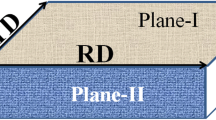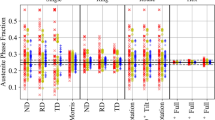Abstract
There is currently no general agreement on how to extract the volume fraction of texture components for aluminum alloy sheets based on X-ray diffraction (XRD) and electron backscatter diffraction (EBSD) techniques. In order to clarify this problem, grain orientation data of AA5754 sheet material in the O-temper were acquired using XRD and EBSD. The volume fractions of 10 selected texture components were calculated using the MTM FHM software package for XRD and EDAX-TSL OIM Analysis for EBSD. The measured grain orientation data from EBSD were then processed again using MTM FHM. The results show that there are no significant differences in the constructed pole figures using different measuring techniques when the same analysis system is used. Thus, the differences in volume fractions of texture components are mainly related to the deviation angle used in the two different software packages. The differences in the deviation angle used lead to potential overlaps between the selected texture components. A suitable deviation angle for the volume fraction calculation can be selected using the concept of misorientation.



Similar content being viewed by others
References
P.D. Wu, D.J. Lloyd, M. Jain, K.W. Neal, Y. Huang: Int. J. Plasticity, 2007, vol. 23, pp. 1084–1104
P. Van Houtte: Text. Microstr., 1984, vol. 6, pp. 137–62
S.I. Wright, J.F. Bingert, and M.M. Nowell: Metall. Mater. Trans. A, 2007, vol. 38A, pp. 1845–55
W.C. Liu, J.G. Morris: Scripta Mater., 2002, vol. 47, pp. 743–48
H. Azari, D.S. Wilkinson, D.J. Lloyd: Metall. Mater. Trans. A, 2005, vol. 35A, pp. 1839–51
J. Sarkar, T.R.G. Kutty, K.T. Conlon, D.S. Wilkinson, J.D. Embury, D.J. Lloyd: Mater. Sci. Eng., 2001, vol. A316, pp. 52–59
H.-J. Bunge: Texture Analysis in Materials Science. Mathematical Methods, Butterworth and Co., London, 1982
S. Matthies, G.W. Vinel, and Helming K. Helming: Standard Distributions in Texture Analysis, Akademic-Verlag, Berlin, 1987
J.-H. Cho, A.D. Rollett, K.H. OH: Metall. Mater. Trans. A, 2004, vol. 35A, pp. 1075–86
B.L. Adams, S.I. Wright, K. Kunze: Metall. Trans. A, 1993, vol. 24A, pp. 819–31
H. Jin, P.D. Wu, M.D. Ball, D.J. Lloyd: Mater. Sci. Technol., 2005, vol. 21, pp. 419–27
S. de La Chapelle: Scripta Mater., 2001, vol. 45, pp. 1387–91
P.R. Dawson, S.R. MacEwen, P.D. Wu: Int. Mater. Rev., 2003, vol. 48, pp. 86–122
P. Sonnweber-Ribic, P. Gruber, G. Dehm, E. Arzt: Acta Mater., 2006, vol. 54, pp. 3863–70
P.D. Wu, D.J. Lloyd, A. Bosland, H. Jin, S.R. MacEwen: Acta Mater., 2003, vol. 51, pp. 1945–57
P. Van Houtte: The MTM-FHM Software System, Version 2, Katholieke Universiteit Leuven, Belgium, 2000
P. Van Houtte: Text. Microstr., 1991, vol. 13, pp. 199–212
S.B. Kang, B.K. Min, H.-W. Kim, D.S. Wilkinson, J. Kang: Metall. Mater. Trans. A, 2005, vol. 36A, pp. 3141–49
D. Raabe, M. Sachtleber, H. Weiland, G. Scheele, E. Ehao: Acta Mater., 2003, vol. 51, pp. 1539–60
K. Kunze, S.I. Wright, B.L. Adams, D.J. Dingley: Text. Microstr., 1993, vol. 20, pp. 41–54
Acknowledgments
The authors are indebted to Professor Anthony D. Rollett, Carnegie Mellon University, Professor Paul Van Houtte, Katholieke Universiteit Leuven (Belgium), and Dr. Anil Sachdev, General Motors R&D Center, for many useful discussions. The authors are grateful for the help of Mr. Robert Kubic, General Motors R&D Center, for carrying out the EBSD measurements. The financial support of General Motors of Canada Ltd. and the Natural Sciences and Engineering Research Council of Canada are gratefully acknowledged.
Author information
Authors and Affiliations
Corresponding author
Additional information
Manuscript submitted May 11, 2007.
Appendix
Appendix
This appendix is written based on Reference 16 to clarify the generation of the model function, f m(g), and also to provide M values for all ten selected texture components in the present study.
In order to generate the model function f m(g), a Gaussian distribution function f m(Φ) for an ideal orientation is defined:
where S = 1/(πΦ0), Φ is the angular distance to an ideal orientation, and Φ0 is the spread around it. The latter term is hereafter referred to as the deviation angle. This model function has a maximum value of M.
It must be noted that the Gaussian distribution function f m(Φ) in Eq. [A1] is a function of angular distance Φ. In the MTM FHM software, f m(Φ) is transformed into a function in the Euler space (f m(g e)) in the form of C coefficients. The relation of Φ and g e = (φ 1 ,ϕ,φ 2 ) is as follows:
where
The procedure of generating model functions can be completed in the IDEALC program in the MTM-FHM software.
The Gaussian distribution has been chosen to calculate the volume fraction for computational convenience in the MTM FHM software. In Eq. [1], f m(g e)/M is actually a weighting function that has a value of 1 at the ideal orientation of a texture component (Figure A1). From Figure A1, it is seen that the orientation distribution function f x(g e) is 100 pct counted in the integral at the ideal orientation. Most of f x(g) is counted in the integral within the spread around the orientation, while very little is counted outside the spread away from the ideal orientation.
The M values of all ten selected texture components with three different spreads (5, 11, and 16.5 deg) are listed in Table AI. From Table AI, it is noted larger M values exist at a smaller spread. This is because the integration of the model function over the full orientation space must be 1. It is also noted that M is different for different texture components. This is due to two reasons. First, the fact that orthorhombic sample symmetry typical for rolling texture is considered when generating a model function. A texture component with lower crystallographic symmetry, e.g., \( {\text{S }}{\left( {{\left\langle {{\text{123}}} \right\rangle }{\left\{ {{\text{634}}} \right\}}} \right)} \) component, would have more equivalent orientations and, therefore, smaller M values to satisfy the condition that the integration of the model function over the full orientation space must be 1. Second, Euler space is nonlinear; while, in principle, the nonlinearity is compensated for in the model functions, some variance may occur in the numerical implementation onto linear grids.
Rights and permissions
About this article
Cite this article
Kang, J., Hu, X., Wright, S. et al. On the Calculation of Volume Fraction of Texture Components in AA5754 Sheet Materials. Metall Mater Trans A 39, 2007–2013 (2008). https://doi.org/10.1007/s11661-008-9539-9
Published:
Issue Date:
DOI: https://doi.org/10.1007/s11661-008-9539-9





